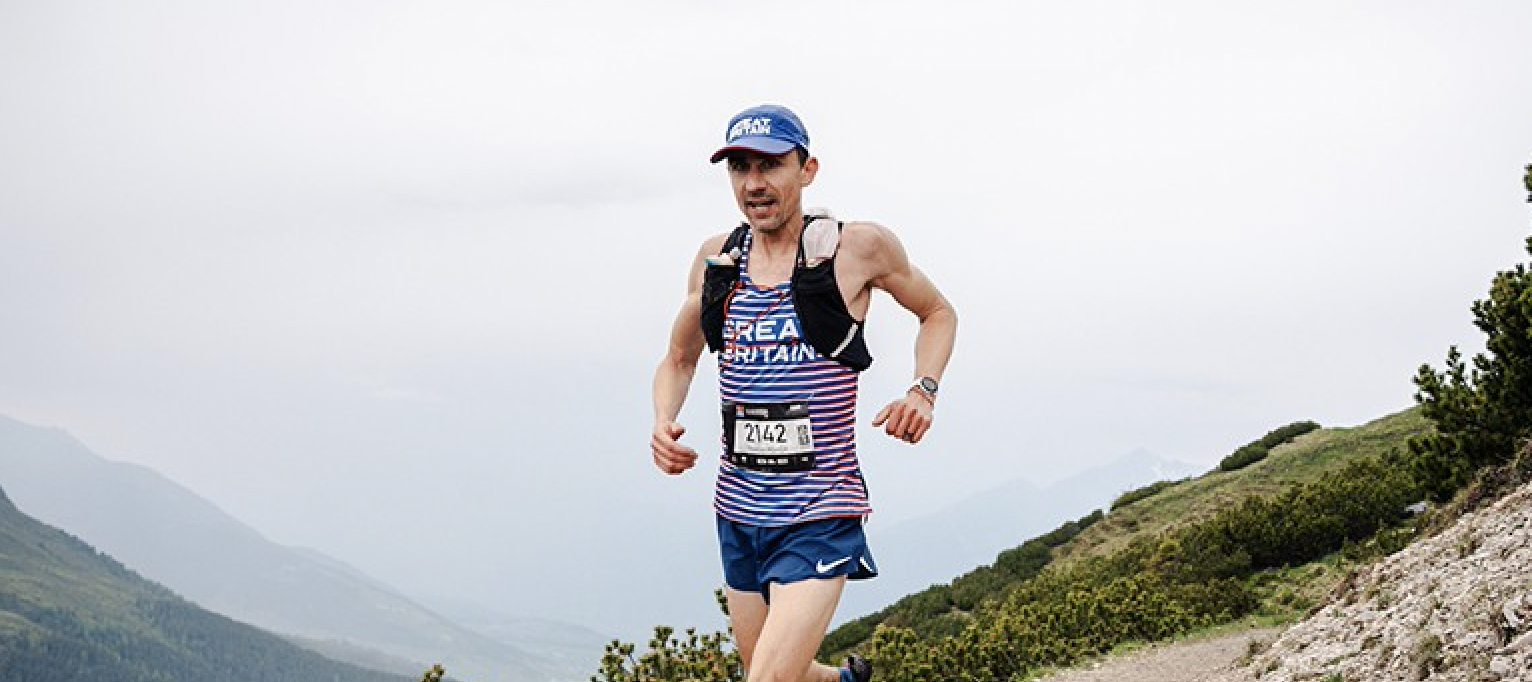Thomas Roach claimed a superb silver medal in Short Trail race at the recent Word Mountain and Trail Runnig Championships in Innsbruck-Stubai, Austria. Together with Jon Albon and Kris Jones, he helped GB win the team Gold medals as well. Many people in the UK are asking, “Who is Thomas Roach?” Here he chats about the championships, how he prepared and how his race unfolded.
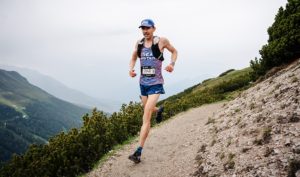
Thomas Roach in the short Trail race at the World Mountain & Trail Running Champs, Innsbruck.
Full details of the championships can be found HERE
Full results from the championships are HERE
AS. A lot of people are asking me now, who is Thomas Roach?
TR. Well, here I am. Hello!.
AS. You’re real, and have a medal around your neck now. I guess for starters, you grew up in Sussex, although currently living in Innsbruck. Briefly describe your early sporting adventures. Were you sporty at school? Did you do any sport when you were younger?
TR. I would say I’ve always been active. I was always the one walking or cycling to school. As a kid, I used to play football, the classic thing, swimming, and a bit of athletics, but nothing serious. The first sport I took seriously was Ultimate Frisbee. I did that for about ten years. I played for my local team in Brighton. We played at a very high level across the UK. It’s an endurance-based sport with a lot of sprinting. At a high level, it’s played with an intensity too. A typical tournament would be six games over a weekend. Each game lasts about an hour and a half. You can sub between points, but each game lasts about an hour and a half. It kills you. I was good enough to be selected for the GB team. That was the last time I represented GB, in 2009 at the European Championships.
We were also competing internationally with our local team from Brighton. I moved to France in 2010 for my post-doc so for my career. I carried on with the frisbee for a while, but I started getting more into trail running. That was around 2011. I ran a race in Switzerland where it’s a flat half, and then you go up 2000 meters. What’s it called? It’ll be on the web somewhere. It’s Interlaken. I ran that and was doing well. I was running with the lead woman for a while. Then I got terrific cramps.
I guess I wasn’t properly trained for it. I moved to Innsbruck in 2012. I left Frisbee behind and started doing a lot more running. Initially, I short things as I was very busy at work and other things in my private life. I was running more roads than the trail. Training on the trails but running road. I was looking to get a sub-30-minute 10K, which was close but not quite there. I only managed that last year for the first time!
So moving forward a little. I was doing various competitions and local trail runs but nothing internationally. My distance has always been something like 25K or a half marathon. It seemed optimal. Then in 2019, I was the Austrian champion in the marathon. ( Authors note Thomas ran 2:24:08) So that’s a road marathon. Since then, I’ve been focusing much more on international trail running. Last year, I did the Golden Trail Series, and I will continue that this year.
AS. So how and when did you become aware of the championships happening in your back yard so to speak?
TR. Well, it was announced last year at a competition I was at. I was running in the Innsbruck Alpine Trail Running Festival. It’s an annual event now. I ran a slightly longer race last year of around 65 kilometres. They announced during that competition that they would hold the world championships. I immediately thought, “WOW!” It would be a great thing to be able to run for Great Britain in that.
I was then in contact with Anne ( Anne Buckley from the British Athletics MRAG Group). She contacted me shortly after that to ask if I would have any interest in running in Thailand at the last championships. I ran in Ireland, at the Masters, uphill. I did well there, getting the gold medal in my category, and the fastest time on the day. At that time, I couldn’t because of work commitments, but I asked her what the qualification procedure was for 2023, She told me about the three peaks being the trial. That inspired me to go to Yorkshire and compete to try and make the team.
AS.So you went to Yorkshire with the idea of qualifying. It was a strong field this year, on a slightly altered course. You won in one of the fastest times ever on the Three Peaks course.
TR. Yes
AS. How did you find the three peaks compared with races you’ve done in Austria?
TR. It was very runnable. The majority of it was very runnable. The little bit of real fell running was adventurous. It was fun. I wish I’d known a little bit more about where to go, but maybe next time. I mean, it’s 35-38 kilometres or something like that. I can’t remember exactly, 38 kilometres and just under 2000 meters up. The long sections of it are very flat.
There’s a good variety of races here. You can get similar races here, which I did very much last year. Yorkshire is the sort of terrain which suits me quite well, to be honest.
My only concern at Three Peaks was that we had to have a map and compass. I was told it was a fell race without any directions, and of course, in Europe, most of the races are incredibly well marked. So you think, oh, god! I’ve never seen the course before. How’s this going to go? After taking the lead, I was constantly asking people for directions. In the end, it worked out.
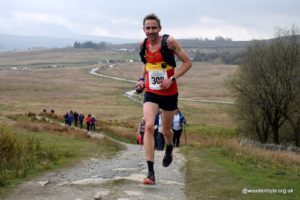
Thomas Roach at 3 Peaks race Pic Woodentops
AS. Winning, the trial got you selected for Britain. Am I right in thinking you did Zagama two weeks after Three Peaks?
TR Yes. When you’re running on the trails, it’s not like road marathons where you’re trashing your quads, and things can take a few weeks to settle down.
AS. Did you recover quickly from the three peaks?
SJ. Yes. I recover quickly generally. From last season I knew that I could recover relatively quickly after races. Anything up to around40 k. Last year, when I did a 63k race, almost exactly a week later, I was doing a 10k road race and got my PB. So I know that is something I can do. Five days recovery and then back to training, then five days training and then two days recovery for the race. It was tight, it’s very tight, but it works.
At Zagama, I was not pushing myself to my limit because I was also very wary that I’d have the World Championships just three weeks after that. I didn’t want to pick up an injury. The conditions were difficult, after the amount of mud and rain. It was technical terrain at the top as well. I saw quite a few runners go over themselves. I was more than happy to finish that in one piece and not get a bad result, to be honest.
AS. Moving forward to Innsbruck. Had you studied the field? Were you aware of how strong the field was? In some ways, that’s a stupid question, as I am sure you did!
TR. I know quite a few of them by now from other races.
Any World Champs field is going to be strong. There were some people I had never competed against. Runners also seem to be coming from slightly different distances. Some from ultra, some from something shorter. You don’t know how they’re going to be on that distance. When I’m racing, I never think about the other racers. I’m thinking about my pace and how I approach the race personally. I’m not chasing people or trying to keep pace with someone. I’m always taking my pace, or the race at the pace I want to run at. I’m not so focused on the others, to be honest.
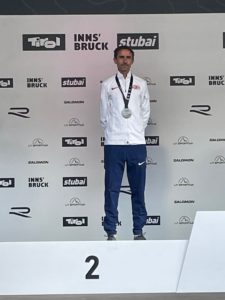
On the podium at the World Mountain and Trail Championships ,Pic Mark Cradle
AS. Obviously, you had local knowledge. How much of the course have you recced? I’m assuming, you know the hills and trails like the back of your hand anyway because you’ve lived there. How often have you been out over the course, getting a feel for it and just getting a feel for knowing this climb is going to take me X amount of minutes?
TR. Getting a good start was critical for me. I worked hard in the first 15 kilometres of the course, especially on the first up and downhill.
I had a couple of slips on that first downhill training early in the season and lost my confidence. I had to practice that many times to build my confidence back up. Downhill it’s a rooty, potentially slippy trail in wet weather. Luckily, we didn’t have wet weather during the race, but it can be pretty nasty as there is some steep ground and many roots, which can cause problems.
I went into the race with confidence for that first section, which helped me. Then it was flat for a while after the first checkpoint, so not much to practice there. Then came the big climb. I had run it a few times up to the second aid station at Mutteralm I hadn’t seen the bit from there to the second Aid station, partly because it was just under so much snow for so late in the season. I don’t think too many people had a chance unless they were doing a recce of the course in the last 10 days or two weeks before the race. The terrain is very much like other places where I’ve run, so the type of terrain is very familiar. The last downhill, I was slightly concerned about. Downhill is not my strongest point. I had run that last downhill a couple of times to feel confident with how steep it was and how I could take it. The news that we needed to follow the exact course and not take shortcuts at the switchbacks suited me. I think that was a benefit for me because that’s how I run anyway.
I’m not a classic British Fell Runner running the shortest line. I always stick to the fastest line because I think we should respect that, but we also need to be aware we are not destroying the local vegetation.
I think it divides opinions, but I think it’s fair if everyone does the same thing. I was happy to hear that we should all follow the paths. I think people are being quite good about doing that, to be honest. I didn’t see anyone cutting corners or doing anything that we weren’t supposed to. Also, when you’re all so close together, I think it’s a bit of a dodgy thing to do anyway because someone will see you and you will get found out.
AS. I have to ask you this. When Stian came up alongside you, what were your thoughts? (Stian is Stian Angermund, the Norwegian who overtook Thomas and went on to win the race )
TR. Oh, we were having a chat, to be honest. We just started chatting. We were talking about the weather and how we felt it was going because you could see the storms coming in. He was telling me how much he was hoping for some rain because we were hot at the time. Stian is someone I haven’t met personally before. So it was quite a nice moment. I always like to get to know people that I’m running with, and he seemed quite up for a bit of a chat as well. I’d say we got to know each other a little bit in those minutes we were running together. As soon as we hit that first big hill, it was obvious he wanted to go up at a faster tempo, and as I was saying, I don’t run someone else’s race. I was not comfortable with the speed he wanted to go at. He wanted to take it on. So we went our separate ways.
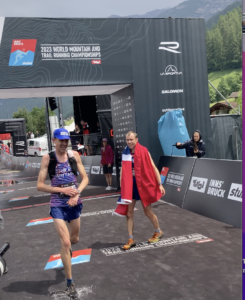
Thomas Roach finishing 2nd at Innsbruck-Stubai. Pic Adrian Stott
AS. You held on incredibly well, but were you aware of how fast Del Peru, the Italian, was coming through behind you?
TR. At the top, I had no idea, but when you’re coming down the hill doing switchbacks, you can hear people, and it sounds much closer than they are. As a bird flies, they are closer to you on the trail, but having to run all the switchbacks means you can keep a distance in front. I knew as soon as I got to that last bit of road that I would fly down, what was it, half a kilometre or kilometre into the town because I was back on my familiar ground and knew I could push on with a good rhythm again. The trouble is I had a horrible sensation in my foot that was killing my toes. I just wanted to get finished as soon as possible. When I got to the road, at the first corner, I looked back and I didn’t see him.
I thought, OK, well, then I should be OK. I wasn’t aware that he was only 45 seconds or 40 seconds behind. It was close in the end, but I managed to hold my form and hold on for second place.
AS. Going into the championships, we all thought you’d run well. Were you aiming for the podium going into the championships?
TR To be honest, I was, not no! I wasn’t aiming for the podium. Of course, you aim for the best you can, and you know you have confidence in yourself. I was thinking a top 10 would be a good result. It’s not that I wasn’t thinking about getting a podium position, but I was thinking top 10 if all goes well. You look at the field and think, “There’s a lot of strong runners out there, people who have shown themselves to be very fast over that distance.” I knew I was in good condition. I had trained well, and was feeling strong, so I wasn’t overly surprised to find myself with the leaders. I was delighted with my run in the end, let’s put it like that.
AS. How does Thomas train? Supplemental to that, do you have a classic training block? Or are you training consistently all year round? Do you take any little breaks? How are six months in the life of Thomas building up to a big race?
TR. Trail running has to reduce in winter here in Austria because of the weather. The conditions here just aren’t conducive to training in the snow. So then I sleep mostly(laughs!) and do the flat road stuff. It depends very much. This year we had quite a late winter. We could carry on trail running up to December, mid-December and January. I had a hard end of the season. The Golden Trails final in Madeira in October was incredibly intense. It was 100 and something kilometres over five days with 7,000 metres of altitude. After that, it took a while for me to recover and get my speed back. Several weeks in fact. I needed some recovery from that, and I was getting through the winter. I picked up a minor injury in late January, which concerned me because it started getting to within weeks of the qualification event. Luckily, it only put me back about four weeks. I picked up my bike. I was then cycling into work rather than running. As you can imagine, cycling here at 7 in the morning is not so fun when it’s minus 10. Your hands and feet are freezing. Occasionally, I would go swimming.
I would say predominantly, in the summer, most of my training is running, but if you look at where my steps come in, only half of my steps are from running, the other half from walking. In the summer, I am averaging 120k a week, but half my steps are from walking, so I’m doing a lot of walking as well as part of my work at the Universit Walking between labs and offices, down to town do shopping, Playing with the kids in the garden. All sorts of things where just being on your feet is also helping. It’s not necessarily intense training, but just literally being on your feet and being active in a way. In terms of specific training, I try to fit in at least three sessions a week. That would be hill sessions, hill intervals, or flat intervals, like kilometres, fast kilometres, or maybe shorter sprints on occasion. Something where you can really raise your pulse and then recover. Classic intervals. Outside of that, it’s just a mixture of running flat, sometimes doing 20k in the morning and then 20k in the evening. Occasionally running at lunchtime. Then, on different days, going out and running anything from 10 to 15k with some hills. I would say moderate to a good pace. Generally, I’m probably running faster than most people would want to train, but it seems to suit me. I’m not doing a lot of slow kilometres, let’s put it like that. When I’m running, if I’ve got the energy, I would tend to push it a little bit. You find where the red lines are and can go with them.
AS. Did you do any specific hills to help prepare for those big climbs in the championship? Any specific training for that, or just getting fit to cope with it?
TR Again, I like putting in the effort when you’re going out there training, Doing like a 30-minute uphill session. Trying to get quite a few hundred meters in. Typically between 3,000 and 4,000 meters a week, up and down. I also train specifically for downhill, not just uphill. That is so important. Not just the uphill, but getting the strength in the legs for coming down hard. Something I’ve been working on recently is more technical downhill. I was avoiding that a lot before because that was how I saw I was most likely to get injured. I didn’t want to do that. However, I realized I was losing more time on the downhills than other pro runners. So it’s something I’ve been working on. I have a long way to go, to be honest.
AS. I think you’re doing something right.
TR. Yes, but I’m working full-time as well. Much of the training is getting to work, on my lunch break, or getting home again.
AS. Coming back to the championships. Apart from your previous frisbee exploits, it was your first major running championship. The combined mountain and trail champs are still a very new concept. This is only the second one. How did you find the whole vibe around the championship compared with an event like Golden Trail Series?
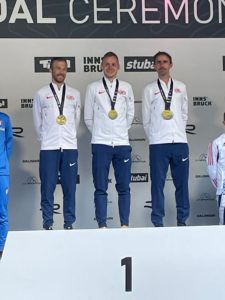
GB Men’s team on the Podium after World Mountain and Trail Championships in Innsbruck-Stubai.L-R Jon Albon, Kris Jones, Thomas Roach. ( Note. Sasha Chepelin, the fourth team runner selected ,had to drop out after suffering an ankle injury early in the race)
TR. In Germany and Austria, I think there’s a good atmosphere around trail running. I found that in the Golden Trails, as much as in the World Championships. Any competition I go to, it’s a very, very nice atmosphere. Everyone is so supportive, pushing themselves to the limit. We are competitive, but at the same time, under a very friendly umbrella.
I thought the Championships themselves were great. It’s nice to have that combination and that diversity of athletes. Runners with different strengths of speed and endurance. What we’re all doing is a combination of both.
AS. There are various arguments put forward that having a championship is one too many events on the calendar. World Athletics has seen what’s going on in the mountains and on the trails with the growth in participation and a rise in standards. They see this event as being a federation-led event rather than a purely commercially-driven event. They are convinced the two can live side by side. Going forward, can you see this championship growing to be a must-do event for a lot of people, or will it just sit as another event in the calendar alongside all the others?
TR, That’s a good question. I don’t know. There is a lot of sponsorship going on inside trail running now. Many runners have to do certain events for their sponsors. I guess that plays a little bit of a role. I think the timing of the championships will also make a difference in who could attend. Holding it either at the end or the beginning of the season would be good because it’s probably a time when it’s less busy on the calendar. I hope it becomes a big event that is a must-do for everyone because I think it’s a chance to compete against the best and to represent your country. It’s an honour for so many people, so I hope it goes in that direction.
If people know 18 months out that there is going to be a World or European champs in September, October, or May, they can plan their seasons much better.
AS. So finally. What’s next for Thomas?
TR. The next thing is a wedding. I’m getting married in a couple of weeks.
AS. Oh! I didn’t realize you were. Congratulations.
TR. We’ve got two children, and it’s been on the cards for a while. Finally, we’re getting married. My next race would be in the Dolomites in mid-July. The Dolomyths run as part of the Golden Trail series. I would also love to do the Karwendemarsch, a famous local race in the Karwendel. It’s a 52k race in a national park just behind Innsbruck. The goal would be to aim for sub-4. It’s about 2,000 meters altitude.
AS.Good luck with that and the rest of your summer, Thanks ever so much for your time, Thomas.
TR. It’s been good to chat.
PLEASE SHARE!
If you have enjoyed this post, do see our other ones HERE
If you are inspired by this or think someone else you know will be, please do what you have to do by sharing. You all know how these things work by now:-) You can also follow me on Twitter and Instagram @tarittweets
